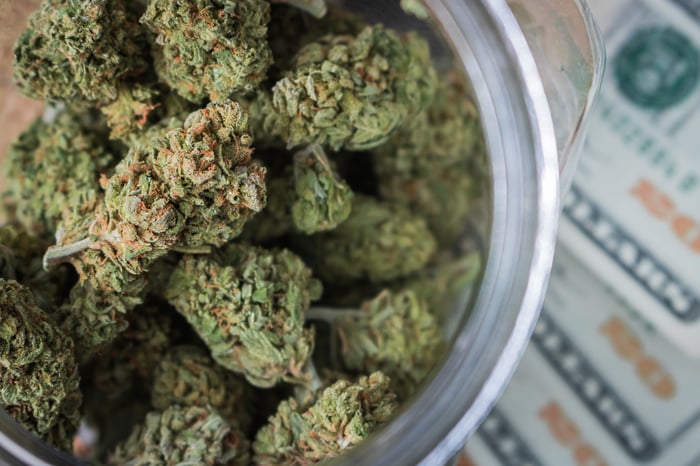Last year, Wall Street was virtually unstoppable. The broad-based S&P 500 underwent only one very minor correction and galloped its way to a 27% gain for the year. It continued what's been the strongest bounce back from a bear-market bottom on record.
Yet in spite of this bounce, Wall Street still sees significant upside in marijuana stocks. Cannabis-focused analytics company BDSA foresees legal weed sales doubling from an estimated $31 billion in 2021 to $62.1 billion by 2026. That's a lot of green that'll be fueled by growth throughout North America.
Based on the high-water 12-month price targets offered by Wall Street analysts and investment banks, three ultra-popular pot stocks stand out as having significant upside potential, ranging from 46% to as much as 152%. But as you'll see, lofty price targets aren't always what they're cracked up to be.

Image source: Getty Images.
Aurora Cannabis: Implied upside of 46%
Among pot stocks listed on major U.S. exchanges, Aurora Cannabis (ACB -5.42%) looks to offer ample return potential. Analyst Pablo Zuanic of Cantor Fitzgerald believes Aurora could climb to $10.75 Canadian ($8.50 U.S.) a share, which would represent upside of 46% over the next year.
At one point, Aurora Cannabis was viewed as the gold standard of cannabis companies. At its peak, it owned 15 production facilities that would have been capable of more than 600,000 kilos of annual weed output, if fully built out. The expectation was for Aurora to be a leading wholesale provider in Canada as well as a key exporter of cannabis to medical marijuana-legal markets.
Unfortunately, Aurora's previous management team grossly overestimated the ramp-up of recreational pot in Canada and the rollout of medical cannabis outside of its domestic market. In response, the company has closed some of its smaller production facilities, halted construction on others, and even disposed of assets, to cut its expenses. Zuanic's price target probably takes into account the expectation of lower costs, modestly higher sales, and a smaller cash outflow.
But even CA$10.75 a share might be asking too much of a company that's reduced its cash outflows but continues to burn through its capital and lose money on a regular basis. As the Canadian adult-useless market has matured, consumers have gravitated to lower-margin value brands, which is doing Aurora Cannabis no favors.
Worse yet, Aurora's primary means of raising capital has been to issue stock. Since mid-2014, the company's share count has ballooned from 1.3 million to 198.1 million. As long as the company continues to lose money, share-based dilution is a tangible negative for the company's shareholders.

Image source: Getty Images.
Sundial Growers: Implied upside of 96%
Another extremely popular pot stock that could see significant gains in 2022, at least if Wall Street is correct, is Sundial Growers (SNDL -2.50%). Zuanic at Cantor Fitzgerald has the highest price target in place on Sundial as well ($1.15). If this prognostication is accurate, shares of the company could nearly double in 2022.
The allure of Sundial continues to be the company's enormous cash position. Taking into account completed and pending acquisitions, the company noted that it had $571 million in unrestricted cash and no debt as of Nov. 9, 2021. Only a couple of cannabis companies have a larger cash position than Sundial.
Zuanic is also likely counting on Sundial's acquisitions to stabilize its operating performance and push the company to positive recurring earnings before interest, taxes, depreciation, and amortization (EBITDA). In July, the company completed its purchase of cannabis retailer Inner Spirit. It's also in the process of buying Alcanna, Canada's largest private liquor retailer.
While there's no denying that Sundial's cash position is a positive, how the company raised this capital is a major negative. Since Sept. 30, 2020, Sundial has issued in the neighborhood of 1.6 billion shares of stock via registered offerings and at-the-market sales. With approximately 2.1 billion shares now outstanding, Sundial's chance of generating meaningful earnings per share is almost nil. To add, with the company's share price well below $1, a reverse split will likely be necessary to avoid delisting from the Nasdaq exchange.
Additionally, even though Sundial generated $11.3 million in net income in the third quarter, it was a $24.1 million gain from derivative warrant revaluation that swung the pendulum. Based solely on its operating performance, Sundial lost $18.8 million in the third quarter and is still a ways from being truly profitable.

Image source: Getty Images.
Canopy Growth: Implied upside of 152%
A final ultra-popular pot stock with incredible upside, per Wall Street, is Canopy Growth (CGC -0.67%). Based on the high-water 12-month price target of CA$28 from MKM Partners, the expectation is for shares to skyrocket 152% in 2022.
The biggest catalyst in Canopy Growth's sails is the four direct and indirect investments the company has received from spirits giant Constellation Brands. As of May 2020, Constellation held a nearly 39% equity stake in Canopy Growth, with enough warrants in its back pocket to eventually own a majority stake. Considering Constellation's success in marketing spirits and developing new brands, the expectation was for this duo to bring infused beverages and other high-margin cannabis derivatives to market.
But as I alluded earlier, things haven't worked in favor of Canadian cannabis companies. Canadians have gravitated to value brands, and the U.S. Congress hasn't been able to make any progress on legalizing weed at the federal level. Although U.S. multi-state operators don't need federal legalization to be successful, Canadian pot producers that want to maintain their listing on the Nasdaq do need federal cannabis reform before they can enter the more lucrative U.S. marijuana market.
To make matters worse, Canopy Growth has burned through a significant amount of cash via overpriced acquisitions and ongoing operating losses. Even with the company reducing general and administrative expenses, slashing share-based compensation, and shuttering a couple of large production facilities, Canopy Growth continues to lose money hand over fist.
Despite being a popular pick in the cannabis space, Canopy Growth is probably still two years away from any chance of recurring profits. In other words, MKM's lofty price target is unlikely to be hit in 2022.





